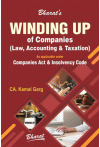
- Author(s): C.A. Kamal Garg
- Publisher: Bharat Law House
- Edition: 1 Ed 2020
- ISBN 13 9789386920843
- Approx. Pages 536 + Contents
- Format Paperback
- Approx. Product Size 24 x 16 cms
- Delivery Time 3-5 working days (within Kerala & South India) (Others 7-9 days)
- Shipping Charge Extra (see Shopping Cart)
...................................................................................................................................................................................................................................
Description
I am pleased to present before the readers the first edition of the book on "Winding Up of Companies — Law, Accounting and Taxation". Winding up is means by which the dissolution of a company is brought about. the means purpose of winding up of a company is to realize the assets and pay the company's debts expeditiously and fairly in accordance with the law. If any surplus is left, it is distributed among the members in accordance with their rights. The Ministry of Corporate Affairs has notified section 255 of the Insolvency and Bankruptcy Code, 2016. Section 255 of the Insolvency and Bankruptcy Code, 2016 amends the companies Act, 2013, in accordance with the Eleventh Schedule of the Insolvency and Bankruptcy Code, 2016. The Central Government appointed 15 November, 2016 as the date on which the provisions of section 255 of the Insolvency and Bankruptcy Code, 2016 shall come into force.
......................................................................................................................................................................................................................................
Contents
Division I : Winding Up under Companies Act
Chapter 1 winding Up under the Companies Act, 2013
Chapter 2 Meetings of Creditors and Contributories
Chapter 3 Registers, Books of Account, Bank Account, Investments and Audit
Chapter 4 Winding Up by Tribunal (Other than Summary Winding Up) Debts and Claims
against Company
Chapter 5 Attendance and Appearance of Creditors and Contributories
Chapter 6 Collection and Distribution of Assets and calls in Winding Up by Tribunal
Chapter 7 Examination under sections 299 and 300 and Application against Delinquent Directors,
Promoters and Officers of the Company
Chapter 8 Disclaimer of Property and Compromise or Abandonment of Claims
Chapter 9 Sale by Company Liquidator
Chapter 10 Dividends and Returns of Capital in Winding Up by Tribunal
Chapter 11 Termination of Winding Up
Chapter 12 Payment of Unclaimed Dividends or Undistributed Assets into the Company Liquidation
Dividend and Undistributed Assets Account in a Winding Up
Chapter 13 Costs and Fees
Chapter 14 Summary Procedure for Liquidation and Inspection of File
Chapter 15 Specimen Forms under Companies (Winding Up) Rules, 2020
Division II : Voluntary Winding Up under Insolvency and Bankruptcy Code
Chapter 1 Voluntary Liquidation of Corporate Entities - An Introduction
Chapter 2 Voluntary Liquidation Process
Chapter 3 Voluntary Liquidation Proceedings
Chapter 4 Closure of Foreign companies - Branch Officer, Liaison Office and Project Officer
Established in India
Chapter 5 Adjudicating Authority for Corporate Persons
Chapter 6 Offences and Penalties
Chapter 7 Specimen Formats useful during Voluntary Liquidation of Corporate Entities
Chapter 8 Specimen Letter of Engagement for Liquidator
Chapter 9 Practice Pointer Issues and the Liquidator
Chapter 10 Voluntary Liquidation of a Corporate Person under IBC - Ready Reckoner
Chapter 11 Information Utility Services
Chapter 12 Documents Required for Voluntary Liquidation Process - a Checklist
Division III : Accounting and Auditing
Chapter 1 Preparation of Financial Statements when going concern does not Apply
Chapter 2 Guidance Note on Reports or Certificates for Special Purpose (Revised)
Division IV : Liquidation and Taxation Aspects
Chapter 1 Liquidation of Corporate Persons and Income Tax Act
Chapter 2 Liquidation of Corporate Persons and GST Law
Appendix 1 National Company Law Tribunal rules, 2016 (relevant extracts)
Appendix 2 Companies (Winding Up) Rules, 2020
............................................................................................................................................................................................................................
Author Details
CA. Kamal Garg [B. Com (H), FCA, DISA (ICAI)] is a Fellow Member of The Institute of Chartered Accountants of India (ICAI) and a First Class Commerce Baccalaureate from Deen Dayal Upadhyaya College, University of Delhi and a consulting academician in KGMA, Delhi.
He was also the member of Board of Studies (BOS) Study Material Research Group (2009-2010) of NIRC of ICAI and a special invitee
member of Accounting Standards Board (ASB) (2012-2013) and Ind AS (IFRS) Implementation Committee (2014-2015) of ICAI. He is also the faculty member of Ethical Standards Board (ESB) of ICAI and had an opportunity to act as a speaker in the very 1st Live Webcast held by ESB of ICAI in March 2013. He is also a key resource person for development and review of various study contents and webcasts for BOS of ICAI, such as study material and practice manual on Advanced Auditing for CA Final, Lectures for CA IPCC and CA Final studies, etc. Besides being a regular guest speaker for IFRS and Management Development Programmes at IBC & PKG, Mumbai, ICAI, ICSI, Direct Taxes Regional Training Institute (North-West Region) for Income Tax Inspectors training programme, he is also an author of over dozens of books including 'Guide to Tax Audit u/s 44AB', 'Foreign Direct Investments in India', 'IFRS and Ind-AS Concepts and Applications', 'Accounting Standards and IFRS', 'Auditors' Practice Manual', 'Handbook on Company's Balance Sheet and Profit & Loss
Account under Revised Schedule VI and XBRL', 'Handbook on Internal Auditing', 'Consolidated Financial Statements', 'Interim Financial Reporting', 'Guide to International Taxation', 'Understanding Goods and Service Tax (GST)', 'Professional Approach to Advanced Auditing' for CA (Final) studies and 'Systematic Approach to Auditing' for CA IPCC studies published by Bharat Law House Private Limited.
............................................................................................................................................................................................................................
